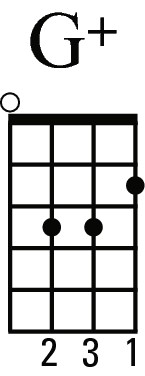Ukulele For Dummies (57 page)
Read Ukulele For Dummies Online
Authors: Alistair Wood
Using Hot Jazzy Chords
One defining characteristic of jazz is its use of complex chords and scales. This section shows you how to change a chord for that jazzy sound in two ways: making it bigger or making it weirder. You make chords bigger by adding notes to create four- and five-note chords (known as
extended chords
) and make them weirder by changing the notes (
augmented chords
).
Extending your chords
The chord family that I examine in Chapter 6 consists of chords that use three notes. But you can extend the chords by adding a fourth note to each. As a result the family in C becomes:
 I: Cmaj7
I: Cmaj7
 ii: Dm7
ii: Dm7
 iii: Em7
iii: Em7
 IV: Fmaj7
IV: Fmaj7
 V: G7
V: G7
 vi: Am7
vi: Am7
Figure 14-5 shows the chord shapes for this family.
Figure 14-5:
Four-note chord family in C.

 You can combine chords in the three- and four-note families to give a jazzy-sounding chord progression such as the one in Figure 14-6 (Track 83).
You can combine chords in the three- and four-note families to give a jazzy-sounding chord progression such as the one in Figure 14-6 (Track 83).
Figure 14-6:
Chord progression using the four-note chord family in C.

Stretching chords even further
Jazz musicians are notoriously restless and they aren't content with chords containing only three and four notes; they love to add colour and variety and use chords with five notes or even more.
Now, if you're really on the ball, you may have noticed a problem here: how do you play a five-note chord on a four-string ukulele?
Strange as it seems, the root note of the chord (flip to Chapter 6 for more on root notes) is the best note to drop. If you're playing with other people this note will get played on bass, guitar or piano. The root note also does least to add to the flavour of the chord, and listeners â even people who aren't musically trained â will instinctively pick up the root note that is suggested. So on the ukulele, a five-note chord such as C9 wouldn't contain a C note.
 When you've started down this route (forgive the pun!), you can add a whole heap of notes to chords. The most common are 6 and 9, which you can find in Appendix A.
When you've started down this route (forgive the pun!), you can add a whole heap of notes to chords. The most common are 6 and 9, which you can find in Appendix A.
So many variations exist that memorising them is difficult. But if you want to get deep into jazz playing, learning the theory behind these chords is worthwhile; it enables you to come up with your own chord shapes when you encounter the names of complex jazz chords (check out
Music Theory For Dummies
by Michael Pilhofer and Holly Day for more in-depth information).
Altering your chords
An
altered chord
is one in which one of the notes has been moved up or down one fret. The most common altered chord is the
augmented
chord. In this book, I represent these with a
+
sign (for example, G
+
) but you can also see them written as Gaug or G
+
5.
The augmented chord creates a lot of anticipation (the listener is dying for the next chord to come along and relieve the tension created by it), and so it works really well at the end of a chord progression. Figure 14-8 takes the jazz turnaround from Figure 14-1 and adds the G
+
chord shown in Figure 14-7.
Figure 14-7:
Chord diagram for the G augmented chord.
